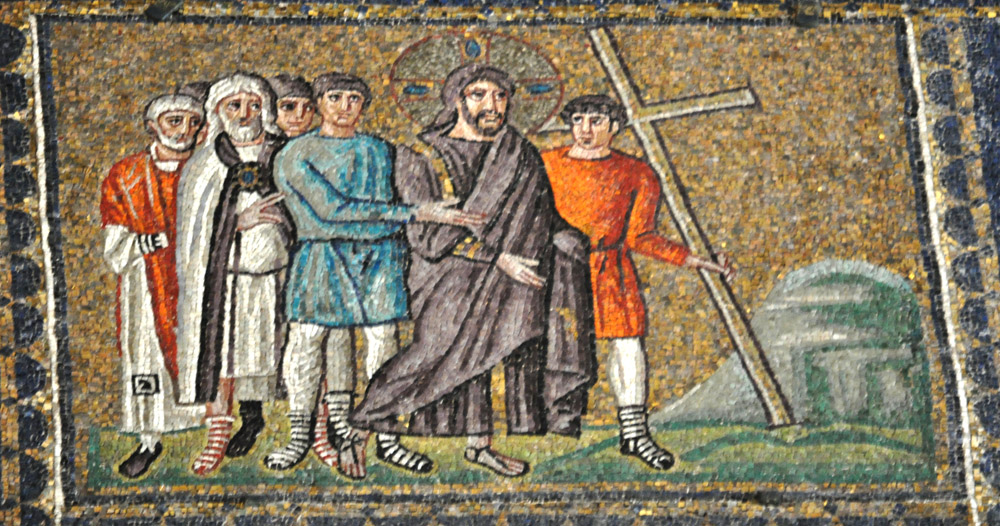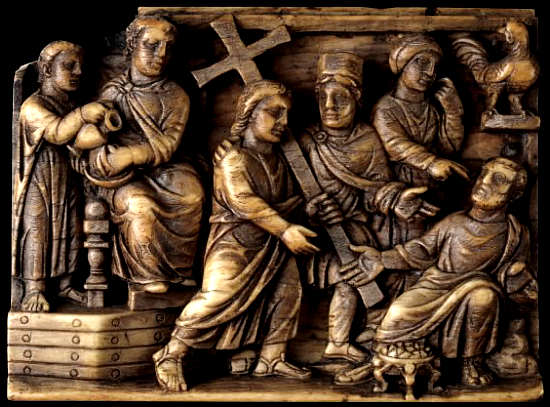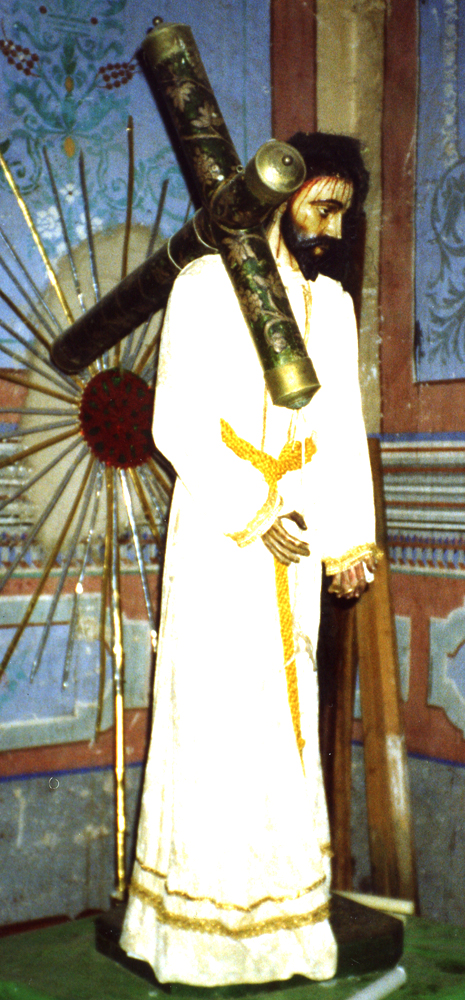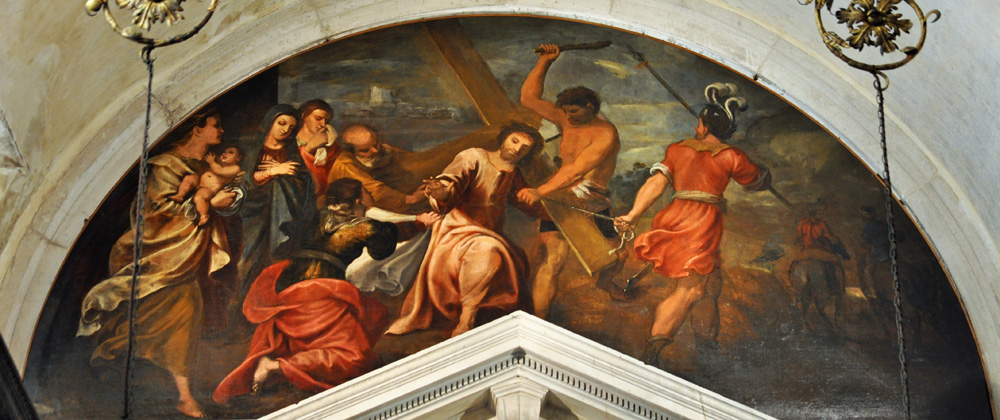However, the great majority of medieval and Renaissance images downplay Simon's assistance in order to emphasize Jesus' physical pain and emotional distress. The picture above is an example: Simon (the bald man) merely offers a bit of help as Jesus falls under the weight of the cross while soldiers torment him.
The increased emphasis on Jesus' pain has the obvious effect of heightening the pathos, but it also serves to show how his suffering was foretold by the prophets and the Psalms. Guilbeau notes especially the influence of Psalm 139:6b, "they have laid for me a stumblingblock by the wayside," on the stone blocks placed along Jesus' path to Calvary in many works of the 15th and 16th centuries (example). He also cites a number of cases where the stumblingblock is re-imagined as a wooden block or plaque fitted with nails and attached by a cord to Jesus' robe (example).
At the far left in the picture is one of the "Daughters of Jerusalem" whom Jesus addresses along the way (Luke 23:28). They and Simon are the only other people mentioned in the gospel accounts of the ascent to Calvary, but over the years many others were added, including St. John and the Virgin Mary (behind Simon in the picture above and in this stained glass) and a woman named Veronica (kneeling in the foreground). It was said that she wiped Jesus' face with her kerchief, and that in gratitude Jesus left on the cloth an image of his own face. See my St. Veronica page for a study of this legend and the images that reflect it. The thieves who were to be crucified with Jesus are not usually in evidence in images of this type, but they are an important element in Tintoretto's Ascent to Calvary.
THE STATIONS OF THE CROSS
Starting in the 15th century Catholic faithful began to practice a devotion known as the Way of the Cross or Stations of the Cross. A number of "stations" would be placed within a church or in an outdoor setting, each of them using a wooden cross to mark a stage in Jesus' ascent from the Pilate's throne up to Calvary. Singly or in groups, the faithful could make a sort of mini-pilgrimage from one Station to the next. It was never required that the wooden crosses be accompanied by images, but that came to be the practice. In 1742 Benedict XIV recommended that every church install a set of fourteen stations. Soon after that, Giandomenico Tiepolo painted the stations for San Polo in Venice.4
By the 20th century a visitor to almost every Catholic church in the United States and Canada would find the fourteen images along the left and right sides of the nave, usually oil paintings with brief titles (example). More recently built or decorated churches tend to have much simpler Stations.
In three of the Stations Jesus falls exhausted under the weight of the cross, a detail missing from any of the gospel accounts but implicit in the suggestion that his physical weakness was the reason he needed Simon of Cyrene's assistance.
SANTOS
Churches in Latin countries used to observe the Way of the Cross with processions during Holy Week featuring life-size santos such as the one in Mexico shown in the third picture on the right and this one in Spain. During the rest of the year the santos would be displayed in the church. In many localities the custom continues to this day. The santos are known by various names in their local sites: El Cristo Nazareno, Cristo de los Afligidos, etc. See our sister site on Oaxaca's santos of Christ Carrying the Cross and Christ Fallen Beneath the Cross.
Prepared in 2016 by Richard Stracke, Emeritus Professor of English, Augusta University.
HOME PAGE
Leonardo Corona, La Salita al Calvario, late 16th century. See the description page for details and interpretation.
OTHER IMAGES

Simon of Cyrene carries the cross in this 6th-century mosaic. See the description page for more about this image.

This 5th-century ivory is the earliest image I have found of Jesus carrying the cross himself. See the description page.

The Santo Nazareño in Cuilapan, Mexico. See the description page for more about this particular santo.
MORE IMAGES
- 13th century: In this detail from a 13th-century triptych Jesus carries his cross as a man in red, probably Simon of Cyrene, taps him on the back.
- 1280-85: In the great central tympanum on the façade of Strasbourg Cathedral it is a woman who tries to help carry the cross. A Jewish official apparently tries to intervene.
- 1303-1305: In Giotto's fresco of the Way of the Cross Jesus glances back at his distraught mother, a detail that will be repeated in later centuries in the fourth "Station of the Cross."
- 15th century: Devotional image of Jesus with the Cross
- 15th century: The left-center panel of an altarpiece in Salamanca pictures Jesus carrying the Cross out of a city gate.
- 1547-51: An altarpiece panel of the carrying of the cross.
- 16th century: Jesus falls and Mary faints in this painting.
- 1748-49: Giandomenico Tiepolo's etchings of the fourteen stations replicate the San Polo paintings but reversed as in a mirror.
- 19th/20th century: A Station of the Cross in a traditional North American church.
NOTES
1 Matthew 27:32, Mark 15:21, Luke 23:26, John 19:16-17.
2 Augustine, The Harmony of the Gospels, III, x: "…Jesus was carrying the cross Himself as He went forth into the place mentioned. But on the way the said Simon, who is named by the other three evangelists, was pressed into the service, and got the cross to carry for the rest of the course until the spot was reached." Jerome notes the apparent contradiction and concludes that "when leaving the pretorium Jesus did carry his cross. They met Simon along the way later and imposed the cross on him" (Commentaries on the Gospel of Matthew, 209 [my translation]).
3 Nicholas of Lyra: "This is not against what is said in John 19…. For he carried his cross at first, when he left Pilate's house, as John says, but because he was fatigued from the previous torments, fasting, and wakeful hours, for that reason the soldiers forced Simon to carry his cross, so that they could get more quickly to the place of crucifixion" Glossa Ordinaria, V, 455 (my translation).
4 Catholic Encyclopedia, s.v. "Way of the Cross."
